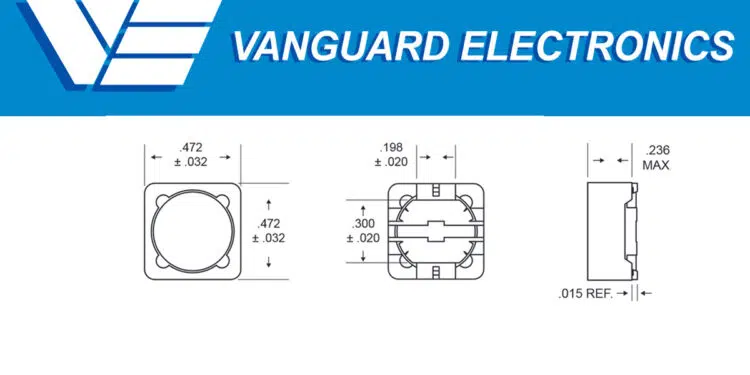The new power inductors from Vanguard Electronics, Huntington Beach, California offer state of the art capabilities for all applications. The parts are shielded and offer inductance ranges up to 1000uH with current ratings up to 8.5A. The parts exhibit very low DCR, which allows for excellent efficiency while keeping heat generated to a minimum. The parts are designed to meet the high shock and vibration commonly tested in MIL-STD-202 and have been tested well more than 100 thermal cycles described by MIL PRF 27.
“The Vanguard team is very pleased to announce the addition of the PL24 and PL25 to its extensive offering of power inductors,” said Scott Harris, Vanguard Electronics Director of Sales. “These new parts have been designed to meet increased market demand for high power and compact magnetics. The parts are offered in a tin/lead termination or in a RoHS offering. The parts are also compliant with MIL STD 981 or can be tested to your source-controlled drawing. In Q1 2022, you expect to release the MIL-STD-981 Space qualified, version SPL24 and SPL25.” Current lead-times are among the industry best, stock to 8-week delivery.”
“This is one of the most robust power inductors to enter the market, “said Jason Finley Vanguard Electronics President. “With operating temperatures from -55°C to + 125°C, this is going to be a workhorse of a part. It can be used in a variety of power applications ranging from missiles to radios, avionics, subsea, space and more. I am very proud of the innovation of the Vanguard team that has combined the high current, high efficiency performance requirements of the industry with the demands of a high reliability environment.”
Full engineering support is available for standard, customized or custom parts. Vanguard Electronics is anISO9001:2015 & AS9100D certified company and is the global leader in the manufacture and development of magnetics for High Reliability, Military QPL and extended temperature inductors and transformers. A cornerstone of Vanguard Electronics focus is on markets that demand, performance, reliability, and innovation.
ELECTRICAL SPECIFICATIONS
- Operating Temperature: −55°C to +125°C
- Storage Temperature: −60°C to +135°C
- Temperature Rise @ 90°C: < 40°C
- Inductance at rated DC: > 70% of initial
- Dielectric Withstanding Voltage: 100 VAC
- Different electrical values available upon request
FEATURES
- Compact, low profile, ideal for automatic placement
- Built to meet MIL-PRF-27 specifications
- Terminations: Tin-lead
- Moisture, Shock and Immersion Resistant
- Magnetically Shielded
- Other termination finishes available
APPLICATIONS
- Filter inductors
- Ripple supressors
- Power supplies
- DC/DC converters
- SEPIC converters































